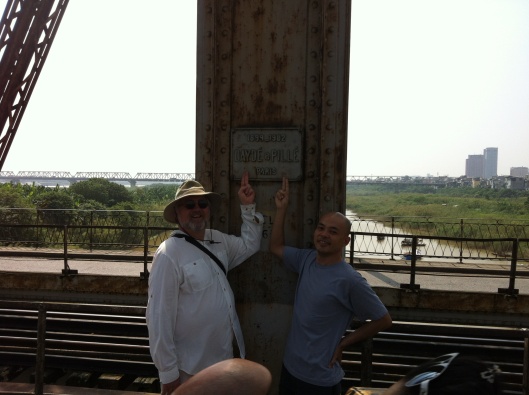Sometimes I don’t think there really are coincidences, just facts. Vũ Nhật Tân eagerly wanted to take us across the Long Biên Bridge via The White Horse Temple in the Old Quarter to the banks of the Red River. We’ve been talking about France and the Việt Nam War a lot while we’ve been seeing each other. So why not deliver the coup-de-grace and present the history of his country in one place?
This historic bridge shares something in common with the next photo, which you will probably recognize as the city of Paris.
Begun in 1899 by the firm of Daydé & Pillé, the Long Biên bridge at the time was the longest bridge in Asia and designed by Gustave Eiffel, but without a soundtrack by Édith Piaf in the background, at least not on the tour we received with Vũ Nhật Tân.
Bombed to little result by us in 1967 during the Vietnam War, the Long Biên Bridge would eventually receive the first “smart bomb” in 1972…
We started our journey in the Old Quarter with a stop at The White Horse Temple. Lunar astrology plays a daily role in life here and it’s good to know your sign. I was born in the Year of the Sheep (1955) and Jan was born in the Year of the Horse (1954). Tân knew this and was happy to show us the main Buddhist Temple of the Old Quarter. Jan felt right at home.
We were meeting journalist Nguyễn Linh Chi this morning, and I think Chi helped both Jan and me navigate the precarious Hà Nội traffic with flying colors!
We pushed through the remaining mile of the Old Quarter to reach the Long Biên Bridge with no idea what surprises were in store, let alone the revelation that the ultimate ghost of Paris would appear courtesy of Gustave Eiffel.
“Hà” means river and “Nội” means between, hence Hà Nội means the City Between the Rivers (the original name was Thăng Long or Ascending Dragon). The Long Biên Bridge is a microcosm of Việt Nam. Chunks were blown up by us in the Việt Nam War, some of Eiffel’s original design remains intact, the Vietnamese have repaired the damage. Without the bridge connecting Hà Nội to Hải Phòng, Hà Nội has no outlet to the ocean, so it is critical real estate.
As one approaches the Red River, we were met by a veritable bread basket of farming, in particular, corn and bananas. Not to mention the lush tropical green that identifies Southeast Asia.
Tân and Chi take a stairway down from the bridge to show us the most unlikely tea vendor on Planet Earth. The area around Long Biên Bridge is farmland but also home to many poor and homeless people. What was amazing about walking in its banana tree farms was the utter peace and quiet, far from the madding crowd of traffic clogged Hà Nội. Tân was sharing his inner sanctum in nature, telling us he will come down to the Red River for hours to listen to the boats and hear the waves lap the shore line.
As we walked the quiet path, only hearing the soothing purr of long boats on the Red River, we came across a Buddhist shrine that was a lesson in compassion. Vietnamese society is dominated by family life, ties and obligations. Everyone is connected by language: sister, brother, aunt or uncle are terms extended throughout the fabric of society.
So use your imagination, as we did not want to take a picture to illustrate what I’m about to tell you. The shrine Tân pointed out to us was for people who were without family or homeless or estranged from their birth families. This Red River shrine provides spiritual dignity to anyone out of luck, so they would not feel alone or fear no one would remember them when they died. From the fresh incense sticks and offerings, it was obvious the shrine meant a great deal to these people. Everyone is connected to everyone else in Việt Nam.
It was not time for a photo….
But we walked on, and the mood changed. There were small villages, with communal communication centers (everyone everywhere is lost without the internet), farms, chickens, geese, duck, fish in the river. In other words life goes on.
After this amazing hike through Việt Nam’s living history, Tân had a brilliant suggestion for the evening. I had been introduced to the old art of ca trù singing through the music of Tốn Thất Tiết but had never heard a live performance.
Recently named an Intangible World Treasure by UNESCO, there was a brilliant performance in another Buddhist Temple at 28 Hàng Buồm Street that evening. Ca trù is akin to the severity of Japanese Noh drama and its poetic language is virtually out of use today. But there are intrepid performances to be heard, with teachers and young students preserving this wonderful Vietnamese music. They sound as good as they look – sheer magic. Tradition is in good hands.
My next blog will be from the magical world of Tam Cốc south of Hà Nội. Here is a preview of coming attractions.
Best, best, best, Jeff











beautiful!